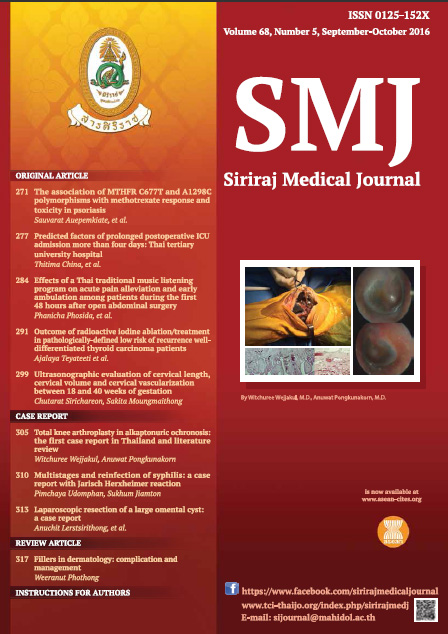Outcome of Radioactive Iodine Ablation/Treatment in Pathologically-Defined Low Risk of Recurrence Well-Differentiated Thyroid Carcinoma Patients
Keywords:
Low risk of recurrence well-differentiated thyroid cancer, radioactive iodine ablation, radioactive iodine treatment, thyroid neoplasmAbstract
Objective: To evaluate outcome of radioactive iodine (RAI) ablation/treatment in pathologically defined low risk of recurrence well-differentiated thyroid carcinoma (WDCT) patients.
Methods: A 7-year retrospective review of medical records was done in 155 pathologically defined low risk of recurrence (LRR) WDTC patients. Total thyroidectomy or equal surgery and pre-ablative evaluation were done in all patients. The 1st dose of RAI ablation was either 30 or 80/100 mCi. The following doses of RAI ablation/treatment were adjusted by patients’ risk of recurrence and treatment response. Criteria of successful ablation/treatment were 1) no evidence of clinical disease 2) no demonstrable abnormal uptake on the follow up 6-12 months diagnostic whole body scan (Dx-WBS) and 3) stimulated thyroglobulin (Tg) lower than 2 ng/mL and thyroglobulin antibodies (TgAb) lower than 40 IU/mL. Patients received RAI ablation/treatment until they achieved disease remission or there was evidence of treatment failure.
Results: Cumulative success rate after the 1st, 2nd and 3rd RAI ablation/treatments were 61.3%, 75.5% and 82.6%, respectively. The risk of recurrence among 155 patients were 83.2% low risk (n=129), 11.6% intermediate risk (n=18), and 5.2% high risk (n=8). Of 129 true LRR patients, the success rates of 1st, 2nd and 3rd RAI ablation were 73.6% (n=95), 10.1% (n=13) and 6.2% (n=8), respectively. After RAI treatment for 3 sessions, disease remission was observed in 10 of 18 intermediate risk of recurrence (IRR) patients and only 1 of 8 high-risk of recurrence (HRR) patients. Between success and failure group, there was statistically significant difference in risk of recurrence (p-value = 0.000), baseline Tg (2.61 vs 7.17 ng/mL, p-value = 0.015) and TgAb (16.8 vs 33.7 IU/mL, p-value = 0.004).
Conclusion: Disease remission in pathologically defined LRR patients after the 1st, 2nd and 3rd sessions of RAI ablation/treatment were 61.3%, 75.5% and 82.6%, respectively. IRR and HRR were found in 16.8% of pathologically defined LRR patients. Risk of recurrence, baseline Tg and TgAb strongly correlated with RAI ablation/treatment outcome. Highest success rate was observed in true LRR (89.9%). None of the IRR and HRR patients had disease remission following the 1st RAI ablation and remission rate was only 43.2% following 3 sessions of RAI treatment.
Downloads
Published
How to Cite
Issue
Section
License
Authors who publish with this journal agree to the following conditions:
Copyright Transfer
In submitting a manuscript, the authors acknowledge that the work will become the copyrighted property of Siriraj Medical Journal upon publication.
License
Articles are licensed under a Creative Commons Attribution-NonCommercial-NoDerivatives 4.0 International License (CC BY-NC-ND 4.0). This license allows for the sharing of the work for non-commercial purposes with proper attribution to the authors and the journal. However, it does not permit modifications or the creation of derivative works.
Sharing and Access
Authors are encouraged to share their article on their personal or institutional websites and through other non-commercial platforms. Doing so can increase readership and citations.











